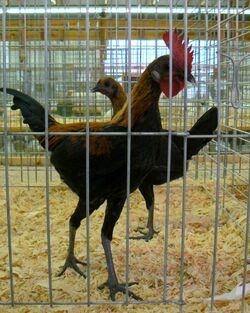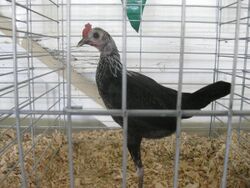Modern Game
Topic: Biology
 From HandWiki - Reading time: 3 min
From HandWiki - Reading time: 3 min
 Brown red Modern Game pair | |
| Conservation status | |
|---|---|
| Country of origin | United Kingdom |
| Standard | PCGB (standard-sized and bantam) |
| Traits | |
| Weight | |
| Classification | |
| APA | all other standard breeds[3] |
| ABA | Modern Game bantam |
| EE | yes[4] |
| PCGB | hard feather[5] |
| |
The Modern Game is a breed of ornamental chicken which originated in England between 1850 and 1900.[6] Purely an exhibition bird, Modern Game were developed to be most aesthetically pleasing and to epitomize the visual appeal of the gamecock or fighting cock.
History
After cockfighting was made illegal in Britain in 1849, many cockfighting enthusiasts turned to breeding for shows as an alternative poultry hobby, and the Modern Game was developed from crosses of Old English Game and Malays.[7]:131 Despite being classified as game chickens (i.e. of cockfighting derivation) in breed standards, Modern Game were not bred to fight.[7]:131
Game, as they were then called, were included in nine colours in the Standard of Excellence in Exhibition Poultry, the first edition of the British Poultry Standard, in 1865; a Game bantam was also included.[8] Eight colours of Game were included in the first edition of the Standard of Perfection of the American Poultry Association in 1874.[3]
Characteristics
Today, the ideal show bird should have a body shaped like a flat iron when seen from above, a relatively short back, fine tail, hard feathering, and a very upright carriage. The breed appears in more than a dozen colour variations. The most common being black red, birchen, brown red, duckwing and pyle. The colours can be broadly divided into two groups; those with willow-coloured legs and red eyes, and those with black legs and dark eyes. The colour of the skin, comb, and wattles varies from red to mulberry depending on variety, but all have a small single comb. Combs and wattles are required to be dubbed (cut off) of all cocks, and any cockerels being shown after November 1st, in order to compete in showing in some countries, which reflects their descent from fighting birds.
As in many breeds, there are both standard and bantam sizes of Modern Game. According to the standard of the Poultry Club of Great Britain, standard-sized cocks weigh 3.20–4.10 kg and hens 2.25–3.20 kg, while bantams weigh 570–620 g and 450–510 g respectively.[2] The bantam version is the most popular among poultry fanciers.
Use
Modern Game are not good egg layers, nor are they valued for meat production. They are almost exclusively kept by competitive breeders. In temperament, they are friendly and curious towards people, and are easily tamed. For this reason the Modern Game is considered a suitable pet for the suburban poultry keeper.[6]
References
| Wikimedia Commons has media related to Modern Game. |
- ↑ Barbara Rischkowsky, D. Pilling (eds.) (2007). List of breeds documented in the Global Databank for Animal Genetic Resources, annex to The State of the World's Animal Genetic Resources for Food and Agriculture. Rome: Food and Agriculture Organization of the United Nations. ISBN:9789251057629. Accessed August 2014.
- ↑ 2.0 2.1 2.2 Victoria Roberts (2008). British poultry standards: complete specifications and judging points of all standardized breeds and varieties of poultry as compiled by the specialist breed clubs and recognised by the Poultry Club of Great Britain. Oxford: Blackwell. ISBN:9781405156424. p. 180–86.
- ↑ 3.0 3.1 APA Recognized Breeds and Varieties: As of January 1, 2012. American Poultry Association. Archived 4 November 2017.
- ↑ Liste des races et variétés homologuée dans les pays EE (28.04.2013). Entente Européenne d’Aviculture et de Cuniculture. Archived 16 June 2013.
- ↑ Breed Classification. Poultry Club of Great Britain. Archived 12 June 2018.
- ↑ 6.0 6.1 Hobson, Jeremy and Lewis, Cecilia. Choosing & Raising Chickens: The complete guide to breeds and welfare. David and Charles publishing. London. 2009. p 62.
- ↑ 7.0 7.1 Carol Ekarius (2007). Storey's Illustrated Guide to Poultry Breeds. North Adams, Massachusetts: Storey Publishing. ISBN 9781580176675.
- ↑ William Bernhard Tegetmeier (editor) (1865). The Standard of Excellence in Exhibition Poultry, authorized by the Poultry Club. London: Poultry Club. p. 20–28; 47
Further reading
- Batty, J (1996). Understanding Modern Game (Fifth ed.). Station Yard Elsted Marsh Midhurst West Sussex GU29 OJT: Beech Publishing House. ISBN 1-85736-313-2.
 |
 KSF
KSF
